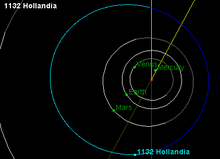1132 Hollandia
1132 Hollandia, provisional designation 1929 RB1, is a stony asteroid from the middle region of the asteroid belt, approximately 27 kilometers in diameter. It was discovered on 13 September 1929, by Dutch astronomer Hendrik van Gent at Leiden Southern Station, annex to the Johannesburg Observatory in South Africa.[13] It was named for the region Holland in the Netherlands.[2]
 1132 Hollandia | |
| Discovery [1] | |
|---|---|
| Discovered by | H. van Gent |
| Discovery site | Johannesburg Obs. (Leiden Southern Station) |
| Discovery date | 13 September 1929 |
| Designations | |
| (1132) Hollandia | |
| Pronunciation | /hɒˈlændiə/ |
Named after | Holland (part of The Netherlands)[2] |
| 1929 RB1 · 1942 NC 1946 JA · 1951 WA | |
| main-belt · (middle) [3] | |
| Orbital characteristics [1] | |
| Epoch 16 February 2017 (JD 2457800.5) | |
| Uncertainty parameter 0 | |
| Observation arc | 86.74 yr (31,680 days) |
| Aphelion | 3.4238 AU |
| Perihelion | 1.9498 AU |
| 2.6868 AU | |
| Eccentricity | 0.2743 |
| 4.40 yr (1,609 days) | |
| 335.62° | |
| 0° 13m 25.68s / day | |
| Inclination | 7.2217° |
| 29.624° | |
| 270.51° | |
| Physical characteristics | |
| Dimensions | 20.48±5.58 km[4] 25.32 km (calculated)[3] 27.235±0.116 km[5] 27.36±0.66 km[6] 27.59±0.78 km[7] 27.727±0.313 km[8] |
| 5.326±0.015 h[9] 5.360±0.001 h[10] 5.568±0.005 h[11] | |
| 0.086±0.013[6] 0.10 (assumed)[3] 0.12±0.06[4] 0.1328±0.0221[8] 0.135±0.008[7] | |
| S [3] | |
| 10.60[7][8] · 11.1[1][3][4][6] · 11.12±0.50[12] | |
Classification and orbit
Hollandia is an assumed stony S-type asteroid. It orbits the Sun at a distance of 1.9–3.4 AU once every 4 years and 5 months (1,609 days). Its orbit has an eccentricity of 0.278 and an inclination of 7° with respect to the ecliptic.[1] The body's observation arc begins with its official discovery observation as no precoveries were taken and no prior identifications were made.[13]
Physical characteristics
Between 2003 and 2014, three rotational lightcurves of Hollandia were obtained from photometric observations taken by French amateur astronomer René Roy, Jason Sauppe at Oakley Observatory and Maurice Clark at TTU's Preston Gott Observatory. Lightcurve analysis gave a rotation period between 5.360 and 5.568 hours with a brightness variation of 0.15–0.35 magnitude (U=2+/2+/2+).[9][10][11]
According to the surveys carried out by the Japanese Akari satellite, and NASA's Wide-field Infrared Survey Explorer with its subsequent NEOWISE mission, Hollandia measures between 20.48 and 27.727 kilometers in diameter, and its surface has an albedo between 0.086 and 0.135.[4][5][6][7][8] The Collaborative Asteroid Lightcurve Link assumes an albedo of 0.10 – a compromise value that lies in between the albedos for carbonaceous (0.057) and for stony (0.20) asteroids – and calculates a diameter of 25.32 kilometers using an absolute magnitude of 11.1.[3]
Naming
This minor planet was named after the Latin name for Holland, a region in the Netherlands.[2] Naming citation was first published by Paul Herget in The Names of the Minor Planets in 1955 (H 106).[2]
References
- "JPL Small-Body Database Browser: 1132 Hollandia (1929 RB1)" (2016-06-08 last obs.). Jet Propulsion Laboratory. Retrieved 1 February 2017.
- Schmadel, Lutz D. (2007). "(1132) Hollandia". Dictionary of Minor Planet Names – (1132) Hollandia. Springer Berlin Heidelberg. p. 96. doi:10.1007/978-3-540-29925-7_1133. ISBN 978-3-540-00238-3.
- "LCDB Data for (1132) Hollandia". Asteroid Lightcurve Database (LCDB). Retrieved 1 February 2017.
- Nugent, C. R.; Mainzer, A.; Masiero, J.; Bauer, J.; Cutri, R. M.; Grav, T.; et al. (December 2015). "NEOWISE Reactivation Mission Year One: Preliminary Asteroid Diameters and Albedos". The Astrophysical Journal. 814 (2): 13. arXiv:1509.02522. Bibcode:2015ApJ...814..117N. doi:10.1088/0004-637X/814/2/117. Retrieved 1 February 2017.
- Masiero, Joseph R.; Grav, T.; Mainzer, A. K.; Nugent, C. R.; Bauer, J. M.; Stevenson, R.; et al. (August 2014). "Main-belt Asteroids with WISE/NEOWISE: Near-infrared Albedos". The Astrophysical Journal. 791 (2): 11. arXiv:1406.6645. Bibcode:2014ApJ...791..121M. doi:10.1088/0004-637X/791/2/121. Retrieved 1 February 2017.
- Masiero, Joseph R.; Mainzer, A. K.; Grav, T.; Bauer, J. M.; Cutri, R. M.; Nugent, C.; et al. (November 2012). "Preliminary Analysis of WISE/NEOWISE 3-Band Cryogenic and Post-cryogenic Observations of Main Belt Asteroids". The Astrophysical Journal Letters. 759 (1): 5. arXiv:1209.5794. Bibcode:2012ApJ...759L...8M. doi:10.1088/2041-8205/759/1/L8. Retrieved 1 February 2017.
- Usui, Fumihiko; Kuroda, Daisuke; Müller, Thomas G.; Hasegawa, Sunao; Ishiguro, Masateru; Ootsubo, Takafumi; et al. (October 2011). "Asteroid Catalog Using Akari: AKARI/IRC Mid-Infrared Asteroid Survey". Publications of the Astronomical Society of Japan. 63 (5): 1117–1138. Bibcode:2011PASJ...63.1117U. doi:10.1093/pasj/63.5.1117. Retrieved 17 October 2019. (online, AcuA catalog p. 153)
- Mainzer, A.; Grav, T.; Masiero, J.; Hand, E.; Bauer, J.; Tholen, D.; et al. (November 2011). "NEOWISE Studies of Spectrophotometrically Classified Asteroids: Preliminary Results". The Astrophysical Journal. 741 (2): 25. arXiv:1109.6407. Bibcode:2011ApJ...741...90M. doi:10.1088/0004-637X/741/2/90.
- Sauppe, Jason; Torno, Steven; Lemke-Oliver, Robert; Ditteon, Richard (December 2007). "Asteroid Lightcurve Analysis at the Oakley Observatory - March/April 2007". The Minor Planet Bulletin. 34 (4): 119–122. Bibcode:2007MPBu...34..119S. ISSN 1052-8091. Retrieved 1 February 2017.
- Clark, Maurice (January 2015). "Asteroid Photometry from the Preston Gott Observatory". The Minor Planet Bulletin. 42 (1): 15–20. Bibcode:2015MPBu...42...15C. ISSN 1052-8091. Retrieved 1 February 2017.
- Behrend, Raoul. "Asteroids and comets rotation curves – (1132) Hollandia". Geneva Observatory. Retrieved 1 February 2017.
- Veres, Peter; Jedicke, Robert; Fitzsimmons, Alan; Denneau, Larry; Granvik, Mikael; Bolin, Bryce; et al. (November 2015). "Absolute magnitudes and slope parameters for 250,000 asteroids observed by Pan-STARRS PS1 - Preliminary results". Icarus. 261: 34–47. arXiv:1506.00762. Bibcode:2015Icar..261...34V. doi:10.1016/j.icarus.2015.08.007. Retrieved 1 February 2017.
- "1132 Hollandia (1929 RB1)". Minor Planet Center. Retrieved 1 February 2017.
External links
- Asteroid Lightcurve Database (LCDB), query form (info)
- Dictionary of Minor Planet Names, Google books
- Asteroids and comets rotation curves, CdR – Observatoire de Genève, Raoul Behrend
- Discovery Circumstances: Numbered Minor Planets (1)-(5000) – Minor Planet Center
- 1132 Hollandia at AstDyS-2, Asteroids—Dynamic Site
- 1132 Hollandia at the JPL Small-Body Database
